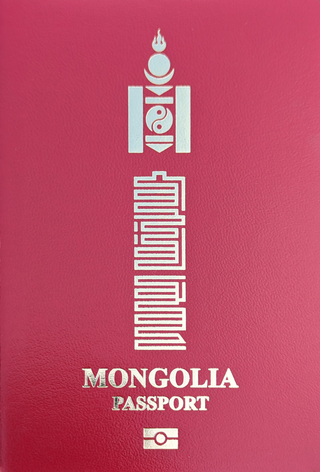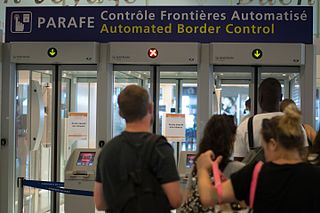Related Research Articles

SmartGate is an automated self-service border control system operated by the Australian Border Force and New Zealand Customs Service and located at immigration checkpoints in departure and arrival halls in ten Australian international airports, and 4 New Zealand international airports. SmartGates allow Australian ePassport holders and ePassport holders of a number of other countries to clear immigration controls more rapidly, and to enhance travel security by performing passport control checks electronically. SmartGate uses facial recognition technology to verify the traveller's identity against the data stored in the chip in their biometric passport, as well as checking against immigration databases. To use the SmartGate system, the traveller must have a biometric passport from Australia, New Zealand or certain other countries. The ePassport gate scanner reads all the information contained in the chip inside the passport and runs the data against numerous databases to determine if the traveller is a security risk, while a camera takes a picture of the traveller and an officer at a control station behind the gates checks that the image captured by the camera matches the one on the passport. Once the data verification and facial recognition process is complete, doors will automatically either open, signifying that the traveller is permitted to enter and/or exit the country, or remain closed and a stop icon illuminate, demonstrating that the traveller has failed the security checks and will personally meet with immigration officials.

A Singaporean passport is a travel document and passport issued to citizens and nationals of the Republic of Singapore. It enables the bearer to exit and re-enter Singapore freely; travel to and from other countries in accordance with visa requirements, and secure assistance from Singapore consular officials abroad, if necessary.
A passport stamp is an inked impression in a passport typically made by rubber stamp upon entering or exiting a territory.

Global Entry is a program of the U.S. Customs and Border Protection service that allows pre-approved, low-risk travelers to receive expedited clearance upon arrival into the United States through automatic kiosks at select airports and via the SENTRI and NEXUS lanes by land and sea. As of May 4, 2018, Global Entry was available at 53 U.S. airports and 15 preclearance locations. By April 2018 more than 5 million people were enrolled in Global Entry and approximately 50,000 new applications for the program were being filed monthly.

Visa requirements for Mongolian citizens are administrative entry restrictions by the authorities of other states placed on citizens of Mongolia. As of 2 July 2019, Mongolian citizens had visa-free or visa on arrival access to 62 countries and territories, ranking the Mongolian passport 82nd in terms of travel freedom according to the Henley Passport Index.

Visa requirements for Afghanistani citizens are administrative entry restrictions by the authorities of other states placed on citizens of Afghanistan. In its second quarter 2022 report, the Henley Passport Index indicated that Afghan citizens have visa-free or visa on arrival access to 26 countries and territories, ranking the Afghan passport 112th and most useless passport in the entire world. Obtaining foreign visas from within Afghanistan is difficult as many embassies in Afghanistan have closed since Taliban takeover of the government in August 2021.

Visa requirements for Pakistani citizens are administrative entry restrictions imposed on citizens of Pakistan by the authorities of other states. As of November 2022, Pakistani citizens had visa-free, visa on arrival, or e-visa access to 32 countries and territories ranking the Pakistani passport 109th in terms of travel freedom according to the Henley Passport Index.
Visa requirements for Tongan citizens are administrative entry restrictions by the authorities of other states placed on citizens of Tonga. As of 2 July 2019, Tongan citizens had visa-free or visa on arrival access to 123 countries and territories, ranking the Tongan passport 46th in terms of travel freedom according to the Henley Passport Index.
Visa requirements for Paraguayan citizens are administrative entry restrictions by the authorities of other states placed on citizens of Paraguay. As of 13 April 2021, Paraguayan citizens had visa-free or visa on arrival access to 142 countries and territories, ranking the Paraguayan passport 34th with Panama in terms of travel freedom according to the Henley Passport Index.

Visa requirements for Maldivian citizens are administrative entry restrictions by the authorities of other states placed on citizen

The visa policy of Singapore deals with the requirements to enter Singapore. A foreign national, depending on their country of origin, must meet certain requirements to obtain a visa, which is a permit to travel, to enter and remain in the country. A visa may also entitle the visa holder to other privileges, such as a right to work, study, etc. and may be subject to conditions.
Biometrics refers to the automated recognition of individuals based on their biological and behavioral characteristics, not to be confused with statistical biometrics; which is used to analyse data in the biological sciences. Biometrics for the purposes of identification may involve DNA matching, facial recognition, fingerprints, retina and iris scanning, voice analysis, handwriting, gait, and even body odor.

ePassport gates are automated self-service barriers operated by the UK Border Force and located at immigration checkpoints in arrival halls in some airports across the UK and at the juxtaposed controls in international railway terminals abroad, offering an alternative to using desks staffed by immigration officers. The gates use facial recognition technology to verify the traveller's identity against the data stored in the chip in their biometric passport, as well as run the data against numerous databases to determine if the traveller is a security risk.
Visa requirements for Zimbabwean citizens are administrative entry restrictions by the authorities of other states placed on citizens of Zimbabwe. As of 2 July 2019, Zimbabwean citizens had visa-free or visa on arrival access to 64 countries and territories, ranking the Zimbabwean passport 80th in terms of travel freedom according to the Henley Passport Index.
Visa requirements for Sammarinese citizens are administrative entry restrictions by the authorities of other states placed on citizens of San Marino. As of 2 July 2019, San Marino citizens had visa-free or visa on arrival access to 167 countries and territories, ranking the San Marino passport 20th in terms of travel freedom according to the Henley Passport Index. Currently the San Marino passport is one of the four European "ordinary" passports to provide visa-free access to the People's Republic of China.
Visa requirements for Guyanese citizens are administrative entry restrictions by the authorities of other states placed on citizens of Guyana. As of 9 November 2022, Guyanese citizens have visa-free or visa-on-arrival access to 88 countries and territories, ranking the Guyanese passport 64th in terms of travel freedom according to the Henley Passport Index.
Visa requirements for crew members are administrative entry restrictions imposed by countries on members of the crew during transit or turnaround.
Many countries have entry restrictions on foreigners that go beyond the common requirement of having either a valid visa or a visa exemption. Such restrictions may be health related or impose additional documentation requirements on certain classes of people for diplomatic or political purposes.

PARAFE is a passport verification program operated by France's Direction centrale de la police aux frontières. PARAFE, incorporating automated self-service barriers operated by DCPAF, is located at immigration checkpoints in the arrival and departure halls at the Paris, Marseille, Nice and Lyon airports and at London St. Pancras railway station, offering an alternative to using desks staffed by immigration officers. The gates use facial recognition technology to verify the user's identity against the data stored in the chip in their biometric passport.

Automated border control systems (ABC) or eGates are automated self-service barriers which use data stored in a chip in biometric passports along with a photo or fingerprint taken at the time of entering the eGates to verify the passport holder's identity. Travellers undergo biometric verification using facial or iris recognition, fingerprints, or a combination of modalities. After the identification process is complete and the passport holder's identity is verified, a physical barrier such as a gate or turnstile opens to permit passage. If the passport holder's identification is not verified or if the system malfunctions, then the gate or turnstile does not open and an immigration officer will meet the person. E-gates came about in the mid-2000s as an automated method of reading the then-newly ICAO mandated e-passports.
References
- ↑ "Total cost of the Iris Recognition Immigration System (IRIS)". What Do They Know?. 2 July 2014. Retrieved 25 October 2019.
- ↑ "Eye scanners at England airports turned off". BBC. 16 February 2012. Retrieved 5 April 2014.
- ↑ UKBA. "Using IRIS to enter the UK". Archived from the original on 4 April 2013. Retrieved 27 February 2013.
- ↑ "Iris recognition immigration system (IRIS)". UK Border Agency. Archived from the original on January 9, 2014. Retrieved 5 April 2014.